Saltwater fish are some of the most fascinating and stunning creatures in the world. Not only are they visually captivating, but they can also provide a great source of entertainment and relaxation. If you’re looking for the ultimate underwater experience, you may consider purchasing one of the 10 most expensive saltwater fish.
From the rare Peppermint Angelfish to the Candy Basslet, these fish can range in price from hundreds to thousands of dollars. Each species has unique characteristics and behaviors, making them a great addition to any home aquarium.
So if you’re ready to invest in a luxurious saltwater experience, read on to discover the 10 most expensive saltwater fish you can buy.
10. Candy Basslet
Length: 2.5 inches
Lifespan: 3 to 5 years
Binomial Name: Liopropoma carmabi

The Candy Basslet (Liopropoma carmabi) is an extremely rare, deepwater basslet that provides exhilarating colors to any saltwater aquarium. This fish is on many “holy grail” lists in the aquarium hobby.
The coloration of the Candy Basslet has been described as one of the most beautiful fish we can keep in aquariums and is often difficult to photograph due to its bright colors. The Candy Basslet has an orange background with bright purple and red lines running down the length of the body. The Basslet also has a dark blue on its caudal and dorsal fins.
Did You Know?
Basslets include can change their gender from female to male, they prefer deep reef slopes, and they are sold for high prices in Japan.
9. Japanese Interruptus Angelfish
Length: 8 inches
Lifespan: 2 to 5 years
Binomial Name: Centropyge interrupta
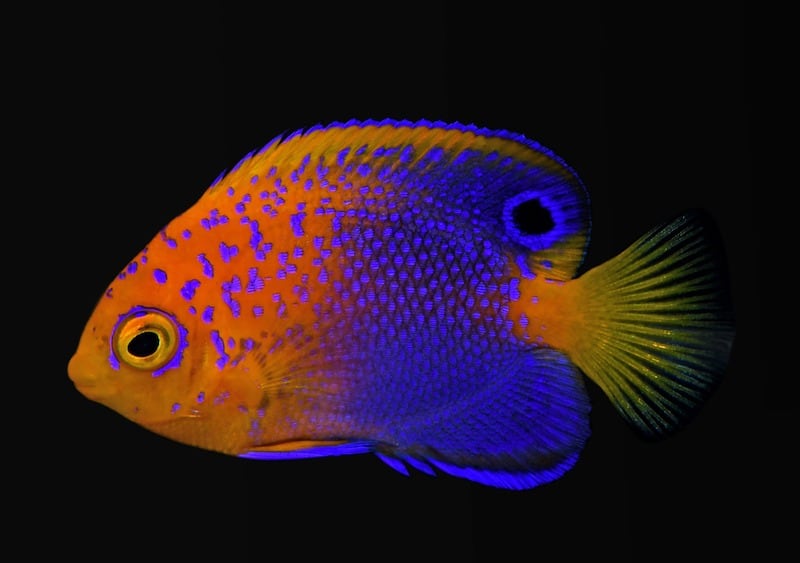
The Japanese Interruptus Angelfish (Centropyge interruptus) is a species of marine ray-finned fish, a marine angelfish belonging to the family Pomacanthidae. It is found in the western Pacific Ocean and is a prized showpiece to any aquarium due to its hardiness and striking vibrant orange, blue, and purple coloration.
These fish inhabit the sub-tropical waters off Japan and can tolerate temperatures from the high 50s to the upper 70s. They can be kept in reef tanks as small as 30-55 gallon tanks with many hiding places when they are young.
Interruptus Angelfish are known for their peaceful nature and are a must for any angelfish aficionado. They feed on algae and benthic invertebrates and are oviparous and monogamous.
Did You Know?
Japanese Interruptus Angelfish are not common in the aquarium trade, but they have been successfully bred and reared in captivity.
8. Clarion Angelfish
Length: 7.9 inches
Lifespan: 15 years
Binomial Name: Holacanthus clarionensis
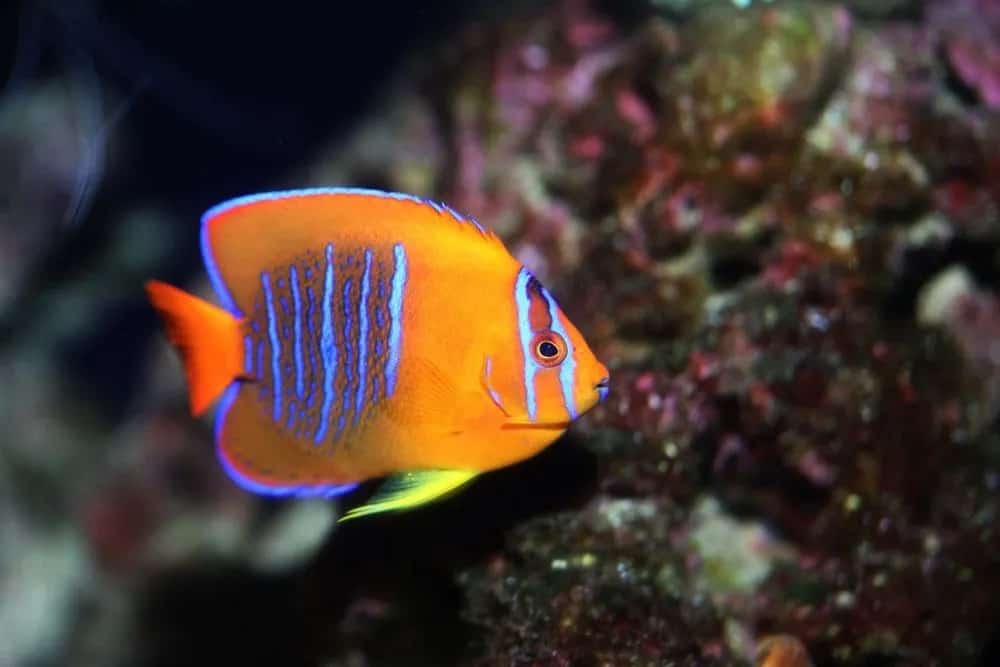
The Clarion Angelfish (Holacanthus clarionensis) is a species of marine ray-finned fish, a marine angelfish belonging to the family Pomacanthidae. It is found in the Eastern Pacific Ocean from the Gulf of California to Panama. It is a large, striking fish with a blue and yellow body and a yellow-orange tail.
It is a popular aquarium species and can reach up to 8 inches in length. Clarion Angelfish feed on benthic invertebrates, algae, and plankton. They inhabit deep drop-offs and are found near coral reefs.
Clarion Angelfish is considered semi-reef safe and can be cautiously kept in reef tanks. They are oviparous, and females can lay up to 600 eggs per spawn.
Did You Know?
It is important to feed Clarion Angelfish a varied diet and provide plenty of hiding places. They are found in the wild but can also be bred in captivity.
7. Wrought Iron Butterflyfish
Length: 6 inches
Lifespan: 7 years
Binomial Name: Chaetodon daedalma
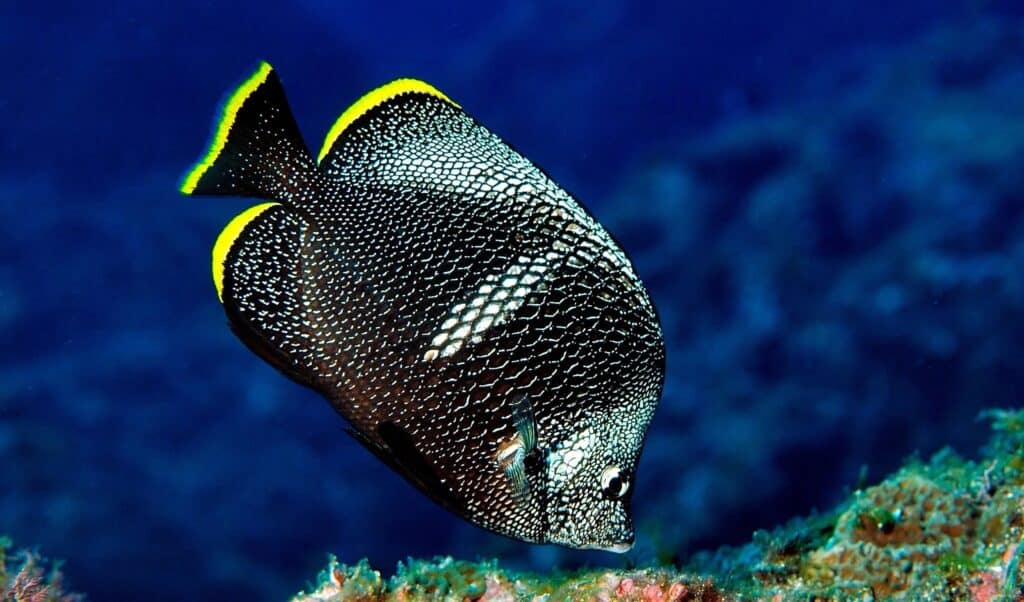
The Wrought Iron Butterflyfish (Chaetodon daedalma) is a species of marine ray-finned fish, a butterflyfish belonging to the family Chaetodontidae. It is endemic to several Japanese islands, making them a rare sight to see anywhere else. The main reason this fish has any commercial appeal is to list it for sale for thousands of dollars in the pet trade.
They are one of the most expensive fish in the world, often priced above $4,000. However, the Wrought Iron Butterflyfish stands out from other species because it isn’t nearly as colorful. Instead, its notable metallic black scales are adorned with hints of yellow, making it a beautiful addition to home tanks for anyone with a penchant for saltwater fish.
Did You Know?
Wrought Iron Butterflyfish are found in the Pacific Ocean near Japan, in depths of at least 33 feet.
6. Neptune Grouper
Length: 10 to 18 inches
Lifespan: 30 to 50 years
Binomial Name: Cephalopholis igarashiensis

The Neptune Grouper (Cephalopholis igarashiensis) is a species of fish that belongs to the Grouper family, Epinephelidae. They are found in the Pacific Ocean, around Japan and Taiwan, and are also known as the Igarashi Grouper or the Blacktip Grouper.
The Neptune Grouper is a relatively small species, usually reaching a maximum length of around 50cm and a weight of about 2kg. They have a dark brown body with some black spots and a lighter brown belly. They have distinctive black tips on their dorsal fins.
Did You Know?
The Neptune Grouper is not as well known as the Giant Grouper but is also considered vulnerable due to its slow growth rate, late maturity, and low reproductive rate.
5. Golden Basslet
Length: 2.5 to 4.6 inches
Lifespan: 3 to 5 years
Binomial Name: Liopropoma Aberrans
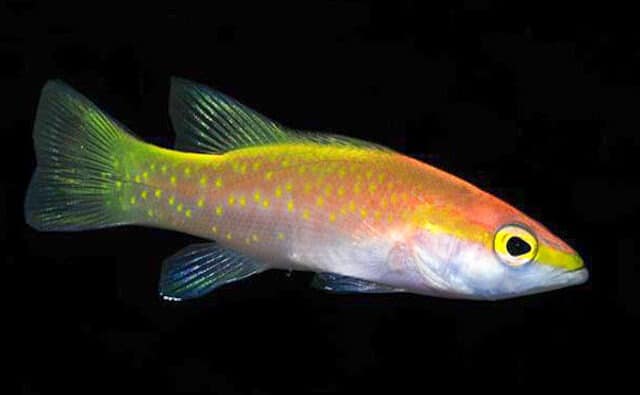
The Golden Basslet (Liopropoma aberrans) is a species of marine fish in the family Grammatidae native to reef environments of the Western Atlantic Ocean. It is a small fish, typically reaching a maximum length of 6 inches.
The Golden Basslet is characterized by its vibrant yellow coloration, contrasted with black spots. It is an oviparous species, meaning that it lays eggs and does not give live birth.
Interestingly, they can change their gender from female to male, and they are more common at a size of around 3.5 inches. They are also a great addition to reef aquariums, and they require a variety of foods to remain healthy.
Did You Know?
Golden basslets are also known as fairy basslets.
4. Peacekeeper Maroon Clownfish
Length: 6.7 inches
Lifespan: 3 to 5 years
Binomial Name: Premnas biaculeatus
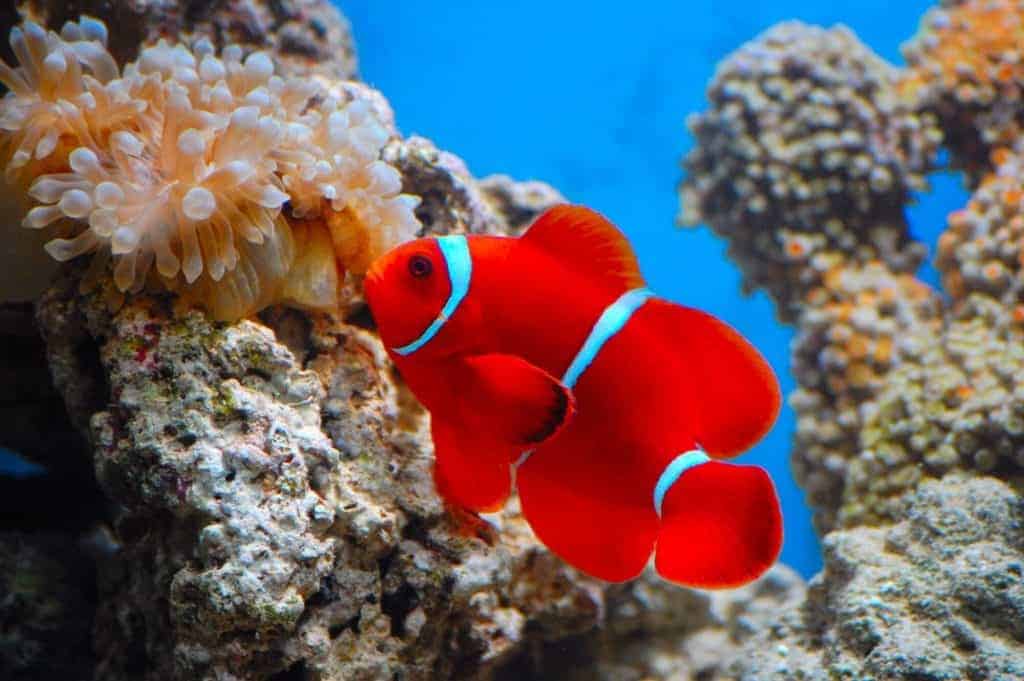
The Peacekeeper Maroon Clownfish (Premnas biaculeatus) is a species of anemonefish found in the Indo-Pacific from western Indonesia to Taiwan and the Great Barrier Reef. They can grow up to be about 17 cm (6.7 in). Like all anemonefishes, it forms a symbiotic mutualism with sea anemones and is unaffected by the stinging tentacles of the host anemone.
It is a sequential hermaphrodite with a strict size-based dominance hierarchy; the female is the largest, the breeding male is the second largest, and the male nonbreeders get progressively smaller as the hierarchy descends.
They exhibit protandry, meaning the breeding male changes to female if the sole breeding female dies, with the largest nonbreeder becoming the breeding male.
Did You Know?
Generally, the Peacekeeper Maroon Clownfish female is maroon to dark brown, while the male and juvenile fish are bright red-orange.
3. Bladefin Basslet
Length: 3 inches
Lifespan: 2 to 5 years
Binomial Name: Jeboehlkia gladifer
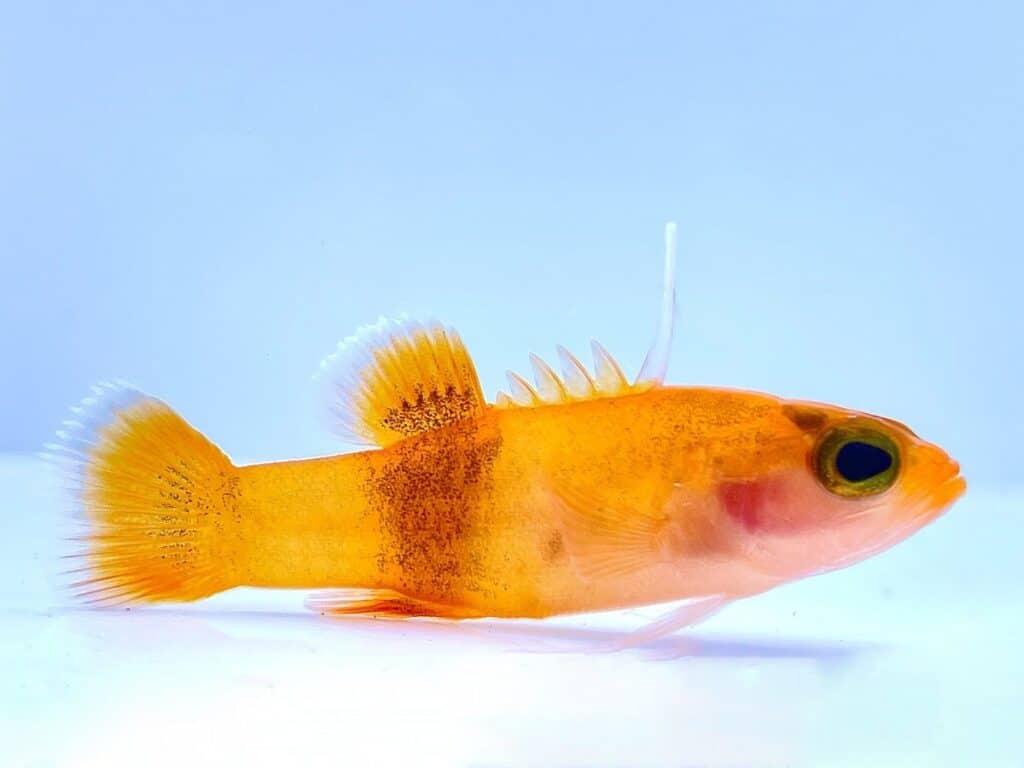
The bladefin Basslet is a small and beautiful fish related to groupers. Unfortunately, it is one of the most expensive aquarium fish in the world because it is attractive and hard to catch, as it routinely lives at depths of over 490 feet.
They are found deep in western Atlantic ocean reefs from the Caribbean to just off the coast of South Carolina and as far north as New York. The price of one of these fish can be as much as $10,000.
Bladefin basslets rarely grow to over 3 inches, and most are smaller than this. They are a peaceful and hardy fish species, making them popular among most marine aquarists. They are known for their vibrant colors and aggressive behavior. The fish’s anal and dorsal fins are edged with white, and it has white pelvic fins.
Did You Know?
Bladefin basslets can thrive in reefs, live in salt water, and enjoy live food.
2. Masked Angelfish
Length: 8 to 8.5 inches
Lifespan: 2 to 6 years
Binomial Name: Genicanthus personatus
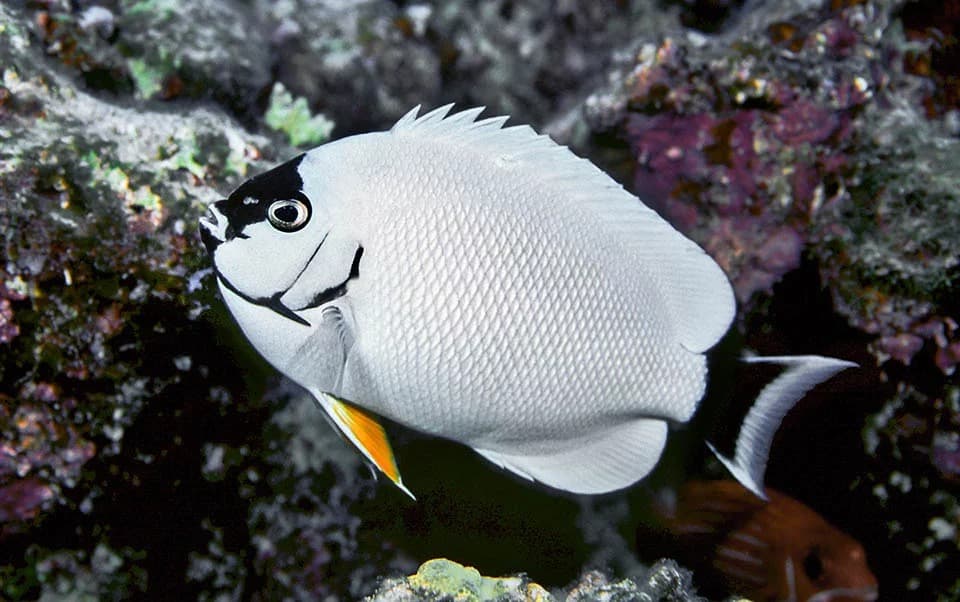
The Masked Angelfish (Genicanthus personatus) is a species of marine angelfish of the family Pomacanthidae, endemic to the Hawaiian Islands. It is a ray-finned fish and is very rare, with only one or two caught a year, if that, which has driven up the price to ridiculous amounts!
It has a pure white body with a thick stripe over its eyes, and its pectoral fins, face, and the edge of the dorsal fins are bright yellow/orange in color. They are protogynous hermaphrodites, so they start their life as females and turn into males later in life. They are omnivores, feeding on clams, shrimp, benthic macroalgae, detritus, crustaceans, fish larvae, and fish scales.
Did You Know?
Masked Angelfish are best housed in a species-only tank or with other peaceful community fish.
1. Peppermint Angelfish
Length: 2.8 inches
Lifespan: 12 to 15 years
Binomial Name: Centropyge boylei
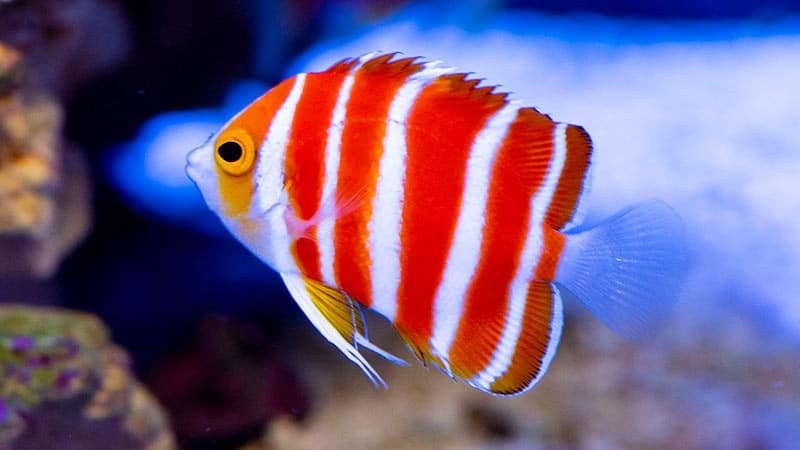
Considered to be the most expensive saltwater fish, the peppermint angelfish (Centropyge boylei) is a relatively small species of marine ray-finned fish. It’s a marine angelfish belonging to the family Pomacanthidae. It is found in the Central area of the South Pacific Ocean and is known to be native to the Cook Islands.
It has a deep, oval-shaped body with five white vertical bands on a reddish-orange background. The dorsal and anal fins have white margins, and the caudal fin is translucent. The face and chin are white. It is found at depths of 55 to 120 meters (180 to 394 ft) on coral rubble, overhangs, and caves in the steep outer slopes of reefs.
Did You Know?
Peppermint Angelfish mostly eat worms and crustaceans.
